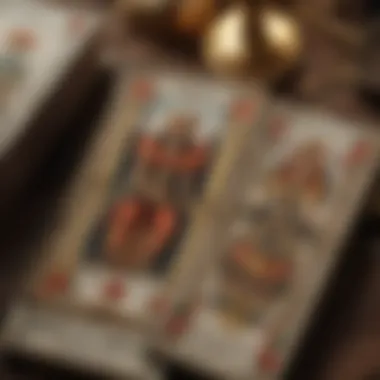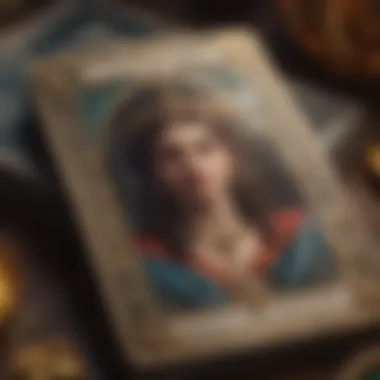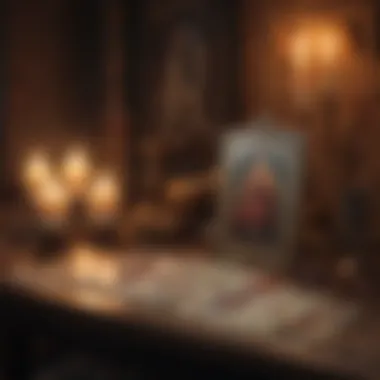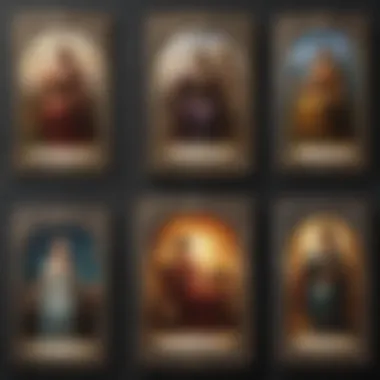Traditional Tarot Cards: An In-Depth Exploration


Intro
Traditional tarot cards represent a complex tapestry of history, art, and human experience. Their roots can be traced back to the 15th century in Europe, moving through a mosaic of cultural influences and transformations. Understanding tarot requires more than just throwing cards; it demands an appreciation for its structural elements and symbolic depth.
The world of tarot is segmented into the Major and Minor Arcana, each contributing to a pattern of meaning and significance. The Major Arcana embodies overarching themes and archetypes, addressing fundamental aspects of the human condition. Conversely, the Minor Arcana deals with life's daily trials and experiences, offering insights that resonate on a more intimate level.
To the untrained eye, these cards may appear to be a mere assortment of illustrations. However, they serve as a channel for introspection and guidance, usable by individuals on a personal growth journey or even in a spiritual context.
The narratives woven into the imagery of each card may vary from reader to reader, yet they share an inherent connection, a collective understanding born from centuries of interpretation. This exploration seeks to uncover the multifaceted nature of tarot, illuminating its value beyond entertainment and promoting its vision as a meaningful practice in the modern age.
The profound utility of tarot lies in its unique blend of historical lineage and contemporary relevance, creating an enduring relationship between the cards and seekers of knowledge.
Our deep dive will examine the significant topics around traditional tarot cards, revealing their historical evolution, structural elements, symbolism, reading methods, and continuing relevance in today's world.
Preamble to Traditional Tarot Cards
The exploration of traditional tarot cards serves as an insightful journey into a rich and multifaceted domain. Tarot encompasses intricate structures and profound meanings that have fascinated individuals for centuries. Understanding tarot means delving beyond simple deck imagery and grasping the philosophical, historical, and spiritual layers it carries. This article offers such a comprehensive perspective, inviting readers to engage with the depth of tarot's significances.
Defining Tarot
Tarot is not just a card game; it is a complex system of symbols and archetypes. The cards collectively tell stories, each card resonating with profound meanings that perception can vastly reshape. Generally, tarot consists of 78 cards divided into two realms: the Major and the Minor Arcana. Often, readers use them not only for divination but also for guidance in personal and spiritual exploration.
Historical Background
Origins in Europe
The origins of tarot in Europe can be traced back to the late 14th century. Initially, tarot decks served as playing cards with no esoteric implications. Their rise to prominence came during the Renaissance period when they were adorned with rich artistic illustrations. The key characteristic of these early decks was the apolitical and social themes they embodied, enabling deeper interaction among players. Their ability to capture human experiences proves beneficial for the article, establishing a foundational context for tarot.
Each deck's unique artistry reflects regional influences, providing a narrative of culture interwoven with historical contexts. This aspect showcases how tarot journeys shaped by artistic heritage can impact interpretations today.
Evolution Through Time
As time progressed, tarot transformed into a spiritual tool, with more layers of meaning attached to each card. The evolution mirrors shifts in society; the Enlightenment brought philosophical depth, while Romanticism infused emotional connection. The adaptability of tarot practices allowed for growth in popularity and application.
Perhaps its most significant evolution occurred during the late 19th and early 20th centuries with the onset of occult movements. The mysterious aura that enveloped tarot led individuals towards metaphysical uses. This, indeed, became a beneficial consideration, revealing the intersections of culture, art, and spirituality imbued in tarot over time.
Influence of Mysticism
Mysticism played a pivotal role in shaping contemporary tarot. Many blame the synthesis of tarot with Kabbalah or astrology for deepening its meanings beyond folklore. Tarot's association with mysticism afforded it an aura of enigma, captivating intuitive seekers and scholars alike.
The mystical influence marks tarot as a richly layered practice, where numerology and symbolism transcend the conventional layout. This characteristic of tarot makes it appealing to esoteric practitioners, enhancing its allure and importance in the discussion of tradition and evolution. Such interactions elevating tarot's position within spiritual discourse underscore its multifatceted relevance.
"Tarot serves not only as a method of divination but also as a significant tool for self-understanding and exploration of the human psyche."
Those studying tarot discover that its depths extend infinitely. The inquiry explored within each layer resonates both personally and universally, making the narrative of traditional tarot cards indispensable for understanding their critical importance today.
The Structure of Tarot Decks
Understanding the structure of tarot decks is crucial for grasping the intricacies of tarot reading. A traditional tarot deck typically comprises two main components: the Major Arcana and the Minor Arcana. Each segment serves a specific purpose and offers unique insights during a reading. Recognizing these elements can enhance readers' interpretations and deepen their connection with the cards.
Major Arcana
Understanding the Trumps


The Major Arcana consists of 22 cards, representing significant life themes and profound spiritual lessons. Each card is often seen as a pivotal moment or experience. This exploration of Understanding the Trumps delves into how these key cards relate to personal growth.
One key characteristic of the suhbject is how it encapsulates the universal human experience. The major cards are distinct; they encapsulate powerful symbolism, making it a multifaceted choice for this article. The unique feature lies in their ability to resonate on varied levels of consciousness.
Understanding these potent cards grants readers more than mere interpretation; it opens avenues for introspection. However, it is important to note potential drawbacks as beginners might feel overwhelmed by the depth of meanings associated with these cards.
Significance of Major Cards
The Significance of Major Cards emphasizes their role beyond mere definitions—it merges understanding with insight, translating the micro within the broader context of the human experience. Key characteristics include the monumental impact these cards can have, marking significant life transitions or challenges.
Readers often find them beneficial in constructing meaningful narratives during readings. The significance lies in the reflective choices made possible by their interpretations. The notable frame across various contexts often contributes great value, yet some may find reliance on major arcana stifles broader readings depending solely on these strongest cards.
Minor Arcana
Suits and Their Meanings
The Minor Arcana further compliments Major Arcana’s narratives, involving 56 cards split into four suits: Cups, Pentacles, Swords, and Wands. Each suit addresses different dynamics of everyday life; the suit of Cups signals emotional states, Pentacles tradies practical matters, Swords presents mental challenges, while Wands sparks creativity and action.
Delving into Suits and Their Meanings enriches an understanding of these daily dynamics among seekers and offers practical grounding. A key aspect is their connections to day-to-day events—assisting the reader to remain anchored amidst life changes. Identifying with specific suits further enables tailored narratives around individuals’ everyday experiences—not uncommon thoughts around tarot readings.
However, these interpretations might introduce complexity for those less familiar with everyday aspects, but familiarity reassures precision and multi-faceted discernment.
Numerical Significance
Nnumerical Significance from the Minor Arcana explains the inherent meanings tied to each card's numeral. Each number, from ace to ten, embodies specific energies or transitions, feeding a narrative adorned with context based on numerology's sacred interpretations. Here algorithmic patterns greet insightful readings mixing results from active over thinkers.
Each rewriting characterizes steps seen in natural progressions; this feature helps conform lives through flowing in reassurance. This structured aspect flanks personal journeys collectively transcending than beneath onscreen estimations asking of importance or requiring depth ensuring customizing interpretive discussions as needed.
Symbolism in Tarot Card Imagery
Symbolism plays a crucial role in tarot card imagery. Each card is not just an image; it conveys deeper meanings that are often layered. Understanding these symbols and their significance can enhance the reading experience. Symbols in tarot help connect the reader with broader concepts or feelings. They offer insights that can lead to powerful reflections and revelations during a reading.
The intricate designs and colors used in tarot cards serve a purpose beyond aesthetics. Each element has a function and contributes to the overall meaning. This association draws from history, cultural traditions, and the collective unconscious. Familiarity with this language of symbols empowers tarologists to deliver more precise interpretations to their clients.
Color and Its Significance
Colors used in tarot design are deeply significant. They affect not just the aesthetics but also the interpretations of the cards. Each color brings its emotions and meanings. For example:
- Red: Often signifies passion, energy, and action.
- Blue: Represents calmness, intuition, and emotional depth.
- Yellow: Connected to intellect, optimism, and clarity.
These colors can alter the reader's perception of the card. For instance, a predominantly red card may inspire thoughts of urgency or conflict, while one with soft blue hues might encourage feelings of serenity and reflection. An awareness of these aspects allows for more nuanced readings.
Common Symbols and Archetypes
Symbols frequently appear across various tarot decks, representing universal themes. Recognizing these symbols and archetypes is essential for any serious tarologist. Here are some important ones:
- The Fool: Represents new beginnings and adventures.
- The Tower: Often signifies chaos or sudden change.
- The Lovers: Symbolizes relationships and choices.
Understanding these archetypes helps in connecting personal experiences to broader narratives. The recurring motifs act as bridges between personal situations and collective human experiences. Readers should tailor their interpretations based on the specific context of the reading and the emotional state of the querent.
By grasping the layers of meaning in symbols and their colors, readers can delve into insights that often transcend surface-level understanding.
Exploring the symbolism and imagery of tarot is a blend of art and intuition. It encourages a deeper comprehension and enhances the overall reading experience, making it a vital aspect of tarot practice.


Methods of Tarot Reading
Methods of tarot reading is crucial within the broader study of traditional tarot cards. Many individuals turn to tarot not only for divination but also for profound self-discovery. Each method applies unique approaches and interpretations, making personal insights possible. Moreover, practicing these methods oftens lead to an enhanced practical understanding of tarot, helping users connect more deeply with their intuitions.
Different Spreads and Their Purposes
When it comes to tarot reading, spreads play a significant role. They refer to how cards are arranged and provide frameworks for interpreting card meanings. Different spreads cater to various objectives, shaping the results of the reading. Two of the most widely used spreads are the Three-Card Spread and the Celtic Cross Spread.
Three-Card Spread
The Three-Card Spread is one of the simplest and most effective methods. Its structure encourages focused readings for immediate questions. Typically, it looks at past, present, and future, offering insights in a straightforward manner.
This spread’s key characteristic is that it only requires three cards, which means less overwhelm for beginners. It provides a practical entry into card reading. Users tend to find it a beneficial and popular choice, especially in fast-paced decision-making situations.
Each card pulled delves into a specific time frame of the query and connects dots effortlessly. A unique feature is its adaptability. Users can customize the focus of questions to suit their current situation, which enhances clarity. However, a disadvantage is that it may lack the depth found in more complex spreads, limiting nuanced exploration regarding personalized queries.
Celtic Cross Spread
Celtic Cross Spread is another renowned method, widely recognized among both novices and seasoned readers. It provides a comprehensive overview of the question at hand through ten card placements. Each position reveals specific information, constructing a narrative around the user's inquiry.
The primary characteristic of this spread is its ability to uncover underlying factors contributing to a person’s life events. This is beneficial for indepth analysis and strategizing future actions. Furthermore, the structure encourages learning. Readers often find themselves gaining unique insights through sophisticated layouts.
What sets the Celtic Cross apart is its versatility: it can cover aspects of circumstances, especially in matters of significant importance. However, this approach may be seen as overwhelming due to its complexity for some users. Careful consideration is essential to balance comprehensive insights with simplicity.
Interpreting Card Combinations
Understanding and interpreting card combinations is essential in further deepening the reading experience. It allows for connections between separate cards to enhance relevanc. Each card emanates its energies and significances. However, it is their interplay that brings about the layers needed for a richer reading.
Recognizing the interaction among multiple cards can influence the reading profoundly. This process involves looking at the positions, suits, numbers, and traditional associations of each card. The effects often vary, providing unique narratives in readings for individuals, relationships, and situations alike. This method conditions the reader to perceive the entirety, ensuring interpretations are neither isolated nor linear.
The Role of Intuition in Tarot
Intuition plays a significant role in the practice of tarot. It acts as a bridge between the subconscious and the conscious mind, allowing for deeper insights during readings. While structured techniques and methods are essential, the personal touch that intuition brings is invaluable. Intuitive skills enhance the interpretation of cards, enabling the reader to connect deeply with both the symbols and the querent's energy. A call to explore the realm of feelings and instincts in tarot has grown quite strong.
Developing Intuitive Skills
Developing one's intuitive skills is a process that involves practice and awareness. Here are some approaches that can aid in enhancing your intuitive abilities:
- Regular Meditation: This can help clear the mind and open channels for intuitive insights. Consistency is key for effectiveness.
- Journaling: Keeping a journal of insights, feelings, and experiences specifically related to reading tarot can track and enhance intuition. Document specific readings and your feelings during those moments.
- Card Affinity: Spend some quiet time with each card. Absorb its imagery and meanings personally rather than relying on standard definitions. This builds a unique connection and strengthens your intuition.
- Play with Spreads: Experimenting with card spreads can open new intuitive flows. Each spread gives a distinctive context and can illuminate different layers of understanding.
Listening to intuitive nudges during readings can sometimes hinge on the quiet moments between thoughts. These flashes of insight can serve to reveal deeper truths not immediately apparent through logic alone. Participation in groups or classes dedicated to tarot and intuition can provide constructive feedback.
Balancing Logic and Intuition
Finding a balance between logic and intuition is central to effective tarot reading. Both elements should not negate each other but work hand in hand. Consider the following aspects:
- Utilizing Structure: Logic provides a framework through which intuition can be applied. This structure often includes the meanings assigned to each card and typical interpretations of various spreads.
- Trusting Your Feelings: While structure is essential, recognising when to trust your gut and employ your intuitive impulses can transform a reading, creating resonance for the client.
- Analytical Thinking: Reflecting on the logical side of a reading allows for more thorough exploration. It helps establish why certain cards are coming up and how they relate to the querent’s concerns.
- Integration with Experience: Combining total experiences during readings empowers subconscious knowledge and facilitates intuitive glimpses. Notes gathered from prior readings serve useful in shaping understanding and can promote informed intuition.
Strategies designed to build a union between logic and intuition lead not just to better readings, but to a richer understanding of the self.
Achieving this balance offers a deeper understanding of the fragility of the human experience. Readers who can harmonize both instinct and analysis facilitate a more rewarding interaction, translating for the querent not just the cards, but comforting guidance that flows from understanding, clarity, and intuition.
Tarot in Modern Society


Tarot cards have adapted and expanded their role in contemporary life. Once associated solely with fortunetelling, they now serve as instruments for personal development and psychological insight. This transformation highlights the tarot's relevance as a multi-faceted tool in today’s society. An increasing number of people are discovering how tarot can accompany them on their journey toward self-awareness and emotional clarity.
Tarot as a Tool for Self-Reflection
The tarot deck offers individuals a mirror to reflect on their thoughts and actions. Each card evokes imagery and symbolism that prompts introspection and offers insights into various life situations. For many, pulling a card isn’t merely predictive but serves as a starting point for deeper self-exploration.
In tarot readings that focus on self-reflection, individuals can achieve several benefits:
- Cognitive Clarity: Engaging with the cards encourages minds to grapple with complex feelings and thoughts.
- Emotional Elucidation: Often, certain cards resonate, leading to breakthroughs in understanding one's emotional landscape.
- Personal Empowerment: Seeking guidance through tarot fosters a sense of control and agency over life choices.
- Continuous Growth: The cyclical nature of tarot allows for repeated reflections as situations change over time.
Integration of Tarot in Therapy
Tarot is gradually being recognized within therapeutic contexts. Many therapists now incorporate tarot as a complementary tool in their practice. This inclusion emerges from the understanding that the cards can unlock new perspectives and facilitate conversations. Integrating tarot in therapy enables various therapeutic effects:
- Art Therapy Link: Cards display rich imagery, which serves as prompts for expressive art therapy.
- Narrative Therapy Assistance: They help clients create and reconstruct narratives around their lives, offering fresh clarity.
- Cognitive Behavioral Strategies: Tarot interventions can encourage visualization and strategizing around personal challenges.
“The tarot deck, elevated to therapeutic heights, allows for new dimensions in behavioral insights.”
The clinical integration of tarot complements existing psychologies. It empowers clients to articulate insights and build emotional awareness while addressing deeper issues in human experience. This newfound alliance paves roads for further research and acceptability. Through these methods, tarot grows a dedicated significance in contemporary psychological practices.
Ethical Considerations in Tarot Practice
The practice of tarot reading requires a balance between interpersonal skills and ethical principles. As tarot readers navigate through the complexities of human emotions and situations, being mindful of ethical concerns is vital. Readers have a responsibility to maintain a high standard of professionalism. Ethical considerations ensure that both the reader and the client are protected in a potentially vulnerable environment. Understanding these tenets can enhance the trust in client-reader relationships and promote a more meaningful experience for everyone involved.
Client Confidentiality
Confidentiality is paramount in tarot practice. Readers often encounter clients during sensitive periods in their lives. Clients may share personal information, fears, and aspirations that reveal intimate details of their lives. Ensuring confidentiality means keeping that information private and secure. When clients know that their privacy is respected, they tend to be more open and honest during sessions.
In practical terms, ethical readers should take the following actions to guard client confidentiality:
- Secure Client Information: Any notes or data should be stored safely. Digital records, if kept, must have strong passwords.
- Avoid Disclosure: Inform others about any readings in general terms without using specific details from a client.
- Clarify Expectations: It is important for readers to discuss confidentiality with clients at the beginning of a session, so both parties are clear about the limits and commitments.
Confidentiality builds trust and safety, both essential ingredients in a successful tarot reading experience.
Honesty in Interpretation
Honesty is the cornerstone of effective tarot reading. Readers should interpret the cards with accuracy and fidelity without manipulating the meaning to meet personal biases or external pressures. A reading that is steeped in honesty allows clients to gain real insight into their situations without sugarcoating the truth.
Practicing honesty involves:
- Providing Genuine Insights: Clearly convey what the cards reveal, even if the information is difficult to deliver. Clients benefit from an accurate portrayal of their circumstances.
- Avoiding Over-promising: It is crucial not to make inflated claims about outcomes. Readers should communicate any uncertainty present in the card revelations.
- Staying Neutral: Anytime a reader feels personal feelings influence their interpretation, they must refocus and maintain neutrality. This allows for a clearer and honest channel of insight.
The ethical principles of confidentiality and honesty elevate the practice of tarot reading, ensuring a professional environment that respects the delicate nature of client interactions.
Culmination: The Lasting Impact of Traditional Tarot
The conclusion of this article serves to encapsulate the enduring significance of traditional tarot cards, weaving together the diverse threads we explored throughout. As we examined the historical foundations, structural makeup, and symbolic interpretations, it becomes evident that tarot transcends mere fortune-telling. This is a tool of self-exploration and understanding.
Summary of Key Points
- Historical Context: Tarot cards originated in the 15th century, evolving through cultural exchanges and becoming steeped in mystical traditions.
- Card Structure: Tarot decks consist of the Major and Minor Arcana, each playing a vital role in readings that provide insight and direction.
- Symbolic Imagery: The imagery on tarot cards holds profound significance, resonating with psychological and spiritual dimensions that enhance readings.
- Reading Methodologies: Various tarot spreads exist, each offering unique perspectives—whether it's a simple three-card spread or a more intricate Celtic Cross.
- Intuition and Ethics: Balancing intuition with logical analysis, alongside ethical practices in reading, ensures a trustful environment for clients seeking guidance.
- Modern Relevance: Tarot's place in contemporary society extends into personal development and therapeutic settings, facilitating deeper connections and self-reflection.
Future Trends in Tarot Practice
The evolution of tarot is ongoing, as new interpretations and practices continue to emerge. Here are some anticipated trends:
- Technological Integration: Digital platforms and apps are paving the way for simplified access to tarot readings, making these insights more accessible to broader audiences.
- Educational Expansion: More resources focusing on educating users in tarot practices, either through online workshops or detailed literature. This will help demystify tarot further.
- Interdisciplinary Approaches: Increasing fits in integrating tarot with psychology, art, and self-help industries, highlighting tarot's potential as a versatile tool.
The lasting impact of traditional tarot is not merely its historical role but its ability to adapt and remain relevant in today’s fast-paced and interconnected world. Its potential for personal growth and understanding will continue to captivate and inspire individuals in the years to come.
In summary, traditional tarot cards offer multifaceted benefits—whether used for introspection or guidance. As we look into the future, it is crucial to embrace both the historical roots and the forward-thinking approaches that will shape the practice of tarot in modern society.







